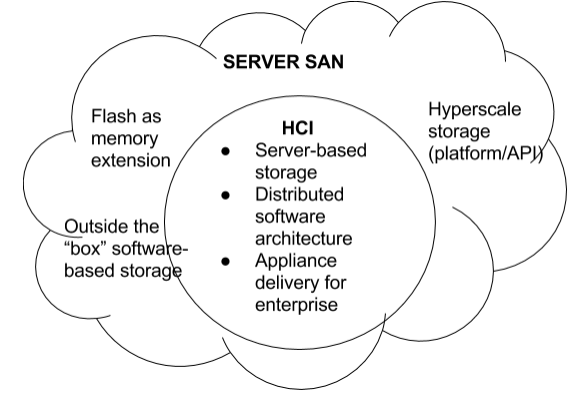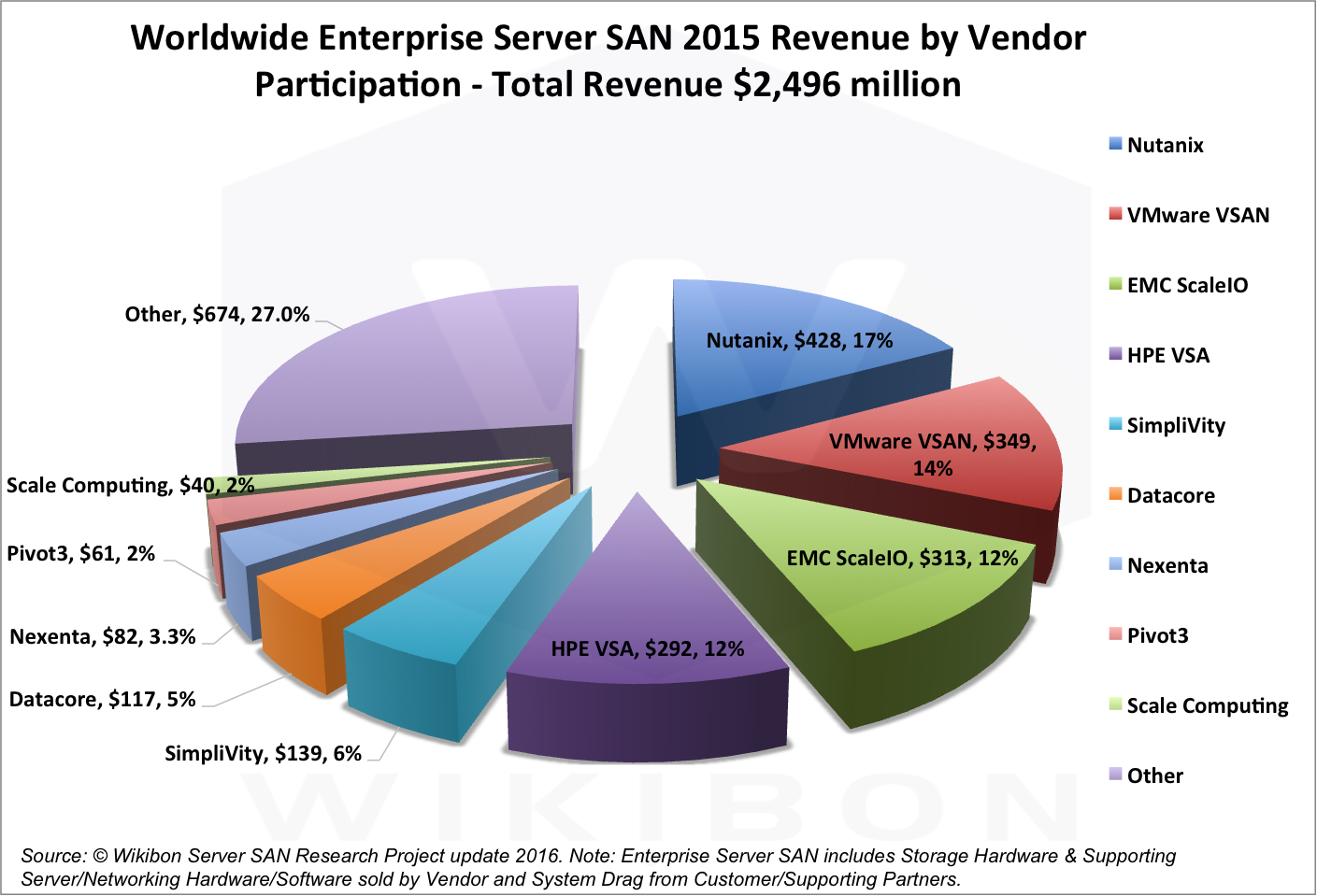See Server SAN Readies for Enterprise and Cloud Domination for full vendor 2015 revenue and 10 year forecast
Premise
The hyperconverged infrastructure (HCI) wave is at a tipping point of adoption. Users should focus on the operational changes that will accompany the adoption of new Server SAN architectures.

When Wikibon first put forth the Server SAN market definition and forecast in 2014, hyperconvergence was not a generally known term, and many considered this architecture to be yet another small piece of the highly fragmented storage marketplace (see Figure 1). The goal of Server SAN architectures is not simply to move from stand-alone storage arrays to server-based solutions, but to remove the challenges of managing storage – perhaps we should call it storageless. While that goal is within reach, users face a number of challenges that will upend storage practices, including:
- Managing the real storage legacy. As server hardware components go down in price and up in commonality, innovation turns to software — which has catalyzed a wave of new storage practices and start-ups. That creates a management challenge: how to evolve infrastructure staff and entrenched vendor relationships.
- Designing for adoption and returns. With well over ten thousand HCI systems deployed from all of the vendors, this category is past the early adopter phase. However, rapid technological evolution coupled with rapid expansion of use cases creates a mish-mash of best practices. Understanding key design constraints is crucial to getting the most out of HCI.
- Planning for change in a fast-moving technology segment. The technologies will evolve rapidly. Which vendors will be able to keep up with the tech and partnership changes?
Managing the Real Storage Legacy
The adoption of all forms of cloud computing – SaaS, public cloud, and hybrid/private cloud – requires that the role of IT and the interaction with technology is transformed. This operational (and often organizational) shift is typically more challenging than the technology adoption. The adoption of solutions that either have a greater amount of automation than traditional IT, or take infrastructure out of the hands of IT (SaaS and public cloud), can cause existential fear from administrators who often have certifications for and years of experience managing certain tasks that are either reduced or eliminated by new solutions. Shops that have successfully navigated the HCI path have found that the transition does require role changes: less administration focused, more business focused. When these changes are embraced, practitioners typically successfully learn new skills that are more strategic for career longevity.
An additional effect of removing much of the operational interaction with infrastructure gear is that it can reduce some of the brand preference for the layers of infrastructure below what they are managing. For example, most Nutanix customers are ambivalent to the SuperMicro-based servers used in the standard configurations; Nutanix also has OEM relationships with Dell and Lenovo, additionally Nutanix has tested its software on Cisco rack servers. The big server vendors – Dell, HPE, Lenovo, and Cisco – are paying a lot of attention to this trend, and all positioning themselves to stay relevant with this wave of HCI adoption. The positive trend for users is that they should be able to spend less time on the repetitive undifferentiated tasks of running infrastructure, and more time on strategic functions that allow the business to grow and innovate.
Getting Designs and Implementations Right
Since there are many differences between the different offerings on the market, and all are continuing to improve code, there are both some misconceptions of perceived limitations and opportunities for continued product development. While many early deployments of HCI were focused on project-based deployments such as VDI, the more mature solutions on the marketplace span most of the spectrum of mixed virtualization workloads.
Scalability is complex issue and one that isn’t easily boiled down to a bullet point; it is a combination of number of nodes (and sites) and performance (latency and IO). Some customers (especially smaller shops) do not require much scalability. Other customers may have application requirements that do not fit well with how compute and storage scale in a specific architecture. There are some software-defined software (SDS) offerings that can also be a hyperconverged infrastructure – for example, EMC’s ScaleIO can be deployed as storage-only configurations, and then later converted to “compute+storage HCI”. There are other SDS offerings that leverage server-based architectures without being fully hyperconverged, such as Datrium, which delivers a storage shelf that includes the server-based software (users leverage their own servers and flash). Users should be sure to be diligent about networking considerations for larger scale deployments, as distributed architectures will often unearth lingering networking issues.
Choose the Vendor, Not the Technology
There are over two-dozen companies delivering product in the HCI category, with over $2B in total 2015 revenue, including a handful of companies generating over $100 million of HCI solutions. The maturity of the solutions and momentum of customer adoption is leading to increased focus on HCI by leading server and storage vendors. Many of the leading suppliers of converged infrastructure (EMC/VCE, HPE, Cisco) have the products in place and are ramping up sales to push harder into HCI marketplace.

Source: © Wikibon 2016
Major HCI moves in the last year:
- Dell is acquiring EMC for $67 billion and sees HCI as one of the top “synergies” of the combined portfolio
- Once the deal closes, Dell owns the full stack for the VxRail architecture (VMware VSAN packaged by the VCE/EMC Converged Platform Division), and also continues to OEM Nutanix’s software.
- Nutanix is making plans to IPO, the S-1 was originally filed in December 2015 and has been updated multiple times
- Cisco launches HyperFlex through the OEM of Springpath software
- It is notable that there have been acquisitions of HCI startups by the storage or server vendors.
- HCI failures include NIMBOXX going out of business and VMware’s EVO:RAIL line quietly replaced by a retooled VxRail
What to expect in the next 12 months
The next year is critical for separating the winners and losers in this marketplace. Server-based architectures like HCI will continue to see rapid adoption. The large storage players will be challenged to successfully balance sales of external storage arrays (including all-flash arrays) sales against the server-based options. While the race to be the first $1B player in this market category favors the vertically integrated stack (Dell/EMC/VMware, HPE, Cisco), HCI solutions are at the core based on software, so Nutanix and others that can maintain differentiation and relevance to the channel have a fighting chance too. The storage market today is highly fragmented into many niche categories, HCI does not resolve this – already there are solutions for SMB/ROBO, very scalable offerings targeting service providers, and application specific solutions.
Action Item
The imperative for CIOs is to have IT adopt solutions that allow for more business innovation and transformation while requiring less labor-intensive operations. The vision of Server SAN is to be a foundational layer for True Private Cloud offerings, and HCI solutions are maturing nicely to meet this requirement. Hyperconverged infrastructure should now be reviewed and compared against any network storage purchase.
Recent videos with leaders from top HCI solutions:
Full coverage from theCUBE at Nutanix’s 2nd annual user conference .NEXT 2016 in Las Vegas https://youtu.be/db4LQqazYmc?list=PLenh213llmcb6di3kP-2syfXy3LnVNfvt
An exclusive 1×1 interview with SimpliVity CEO Doron Kempel
Interviews with EMC Converged Platform Division President Chad Sakac https://www.youtube.com/user/siliconangle/search?query=sakac
Yanbing Li, GM of VMware Storage Business Unit on VSAN momentum


